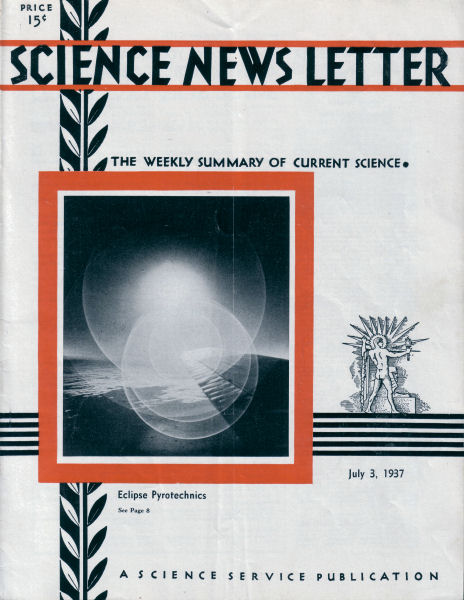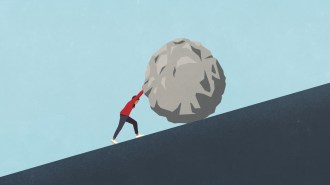From the July 3, 1937, issue

ECLIPSE PICTURE FROM PLANE SHOWS CURIOUS REFLECTIONS
The cover picture of this week’s Science News Letter is from a unique, unretouched photograph, one of a series made by the Hayden Planetarium-Grace Eclipse Expedition. It is one of the occasional astonishing freaks that occur in photography.
It was made looking nearly directly west over the left wing of a Pan American Grace Airways airplane over the coast of Peru at an elevation of 25,000 feet, a second or two before totality of the solar eclipse of June 8. Although only a point of direct sunlight was still visible, this was sufficient to enter the camera lens and cause the central spot of light that appears in the print to be the complete disc of the sun, and to form in addition (through reflection between the several surfaces of the camera lens) a series of circular rings on the negative. In the foreground, 22,000 feet below, the last bit of sunlight is shining on a cloud bank 3,000 feet over the ocean.
The many other pictures of the expedition, though less spectacular than this, have more scientific value. The photograph was snapped by Major Albert W. Stevens.
RECENTLY DESTROYED PLANETS SOURCE OF MANY METEORITES
Many of the chunks of iron that fall flaming and roaring from the sky as meteorites are pieces of a couple of planets that met destruction quite recently, as geology goes—only 100 million years ago, or even less. That was late in the days of the dinosaurs here on Earth, and not long before the “New Deal” that ushered in the age of mammals.
This startling piece of cosmic news was announced before the Denver meeting of the American Association for the Advancement of Science by Dr. William D. Urry of the Massachusetts Institute of Technology.
Dr. Urry has for some years been conducting research on the ages of terrestrial minerals, using a method worked out by Prof. F.A. Paneth of Imperial College, London, and himself. Now for the first time he has applied this method to substances of non-earthly origin—pieces of iron chemically very similar to stainless steel, that are found in all collections of meteorites.
The newest of the 25 iron meteorites thus far examined are these bits of “recently” smashed planets 100 million years old; the oldest is 2,900 million years old. The greater number of the specimens are more than 1,000 million years old, but none exceeds the estimated age of the Earth itself, between 2,000 and 3,000 million years.
Craters on the moon, an astronomical and geological puzzle for many years, are due to violent explosions of meteorites that plunged into the airless surface of the Earth’s satellite with great energy. This theory of the lunar pockmarks was presented to the Society for Research on Meteorites by Dr. L.J. Spencer of London.
Only the 100-mile blanket of air around the Earth protects it from undue damage by meteorites that still bombard it. But Dr. Spencer believes that there must have been an earlier period during which these stray masses of the solar system were much more numerous.
There is little use looking for great masses of iron buried beneath the floors of great meteor craters like the one in Arizona, is the opinion of John D. Boon and Claude C. Albritton Jr. These great gaping holes were probably made by projectiles from the sky, all right, but the projectiles exploded shortly after they hit.
Wartime experience shows what to expect from high-velocity projectiles, even if they contain no explosive charge, they pointed out. Bullets at a velocity of a half-mile a second explode when they hit anything solid enough, even at a glancing angle. And large meteorites fall at speeds approaching a 100 times that of a bullet. Pieces of meteoric iron have been found as much as 6 miles from the craters where the parent body struck and burst.
Said Mr. Boon: “Evidently, when a giant meteorite hits, it penetrates the Earth for a short distance, like an airgun bullet penetrating a piece of cheese; then it explodes.”
STEP TAKEN TOWARD SOLVING QUESTION OF DROPSY’S CAUSE
An important step toward solution of the question of what causes dropsy and one form of kidney disease was reported by Dr. Lillian Eichelberger of the University of Chicago at the meeting of the Federation of American Societies for Experimental Biology.
In dropsy, often associated with kidney and heart disease, watery fluid gets into the body tissues and causes swelling. Nature has fixed it, Dr. Eichelberger explained, so that ordinarily this cannot happen. Otherwise, everyone would swell up after drinking water or beer or other fluid.
For the first time, the condition of faulty water-handling mechanism, known as hydronephrosis, has been produced in animals in the intermediate as well as the final stages, Dr. Eichelberger reported. As a result, scientists can now probe into the underlying cause of the condition with some hope of solving the problem.
Hydronephrosis occurs in some cases of prostate disease and sometimes in pregnancy. Water backs up into the kidneys because the outlets from them are blocked and the pressure destroys the kidneys. It also occurs in renal rickets, an ailment that afflicts children of 10 or 12 years. A disturbing feature of this condition is that the children are without any signs of kidney disease until the last, fatal stage. Dr. Eichelberger’s research may lead to ways of detecting the disease earlier and possibly remedying it.
Alkalinity may be a factor in dropsy. Dr. Eichelberger reported she could get much more fluid into the tissues of the animals if she made their bodies alkaline.
Contrary to previous opinion, Dr. Eichelberger also found that a thin person has no more water in his muscles than a fat person.
Spinach was vindicated at a late session of the meeting. Early reports there had showed that only about one-fifth of the vegetable’s iron content was in such form that the human body could use it.
Dr. C.A. Elvehjem, of the University of Wisconsin, reminded the scientist-physicians that the total content of iron in spinach is so high that one-fifth of it makes a sizable amount.
An unsuspected rickets-preventing element in milk, present after the removal of all traces of the known anti-rachitic vitamin D, was announced to the Society of American Biological Chemists at Memphis by Profs. John M.W. Bunker and Robert S. Harris of the Massachusetts Institute of Technology.







